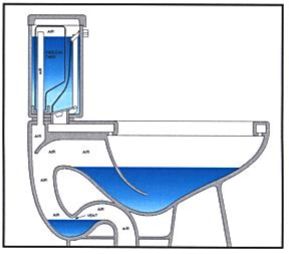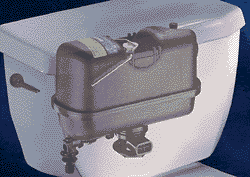
The new
toilets,
which one work!
a report
 A head-to-head comparison for
our readers with nothing to go on
A head-to-head comparison for
our readers with nothing to go on
By Steve Culpepper
At first the toilets in our house were merely sluggish. Then they got slower and slower until they didn't flush at all. But the toilets weren't clogged. Something was in the sewer line. So I rented a sewer snake, unscrewed the clean-out and fed the hungry snake down the chute. In it went-l0 ft., 25 ft., 40 ft. Still, the pipe didn't drain. As I pondered the problem, my young son stuck his head out the window, his little fists full of his favorite action figures, the Teenage Mutant Ninja Turtles. "Turtles live in the sewer, Daddy," he said.
After the snake failed to hit paydirt, I retracted it and fed a garden hose down the sewer line. When the hose could go no farther, I turned up the pressure and just let the water eat. The hose had stewed in the sewer no more than five minutes when a dozen or so plastic Teenage Mutant Ninja Turtles, all horribly chewed by the sewer snake, burbled to the surface. I coiled up the hose and broke the news to my son.
Gone are the days when we could flush toys-
After our sewer was deturtled and the attendant blockage removed, our toilets flushed magnificently. What was amazing was that all those Teenage Mutant Ninja Turtles could ever have been flushed down the toilet at all. But those were the days of the 5-gal. flush. With that much water chasing after them, an entire flotilla of Ninja Turtles could've been flushed home at once-and might have been.
Times have changed since that unclogging. My son is in high school. The Democrats are in the White House. Toilet-flushing capacity dropped from 5 gal. to 3.5 gal., down to the current nationally mandated standard of 1.6 gal.
Our old 5-gal. toilets could flush turtles, cigars, feminine-hygiene products, bullets, Popsicle sticks and an occasional diaper with little effort. The new 1.6-gal. toilets sometimes struggle to flush our humble daily loads of human waste. However, the law's the law, as those who favor the law are fond of saying. And the law is the National Energy Policy Act of 1992, which requires that all toilets made or sold in this country meet new federal water-efficiency standards. To conserve water, those standards set the upper limit of a single flush at 1.6 gal. The law took effect in 1994 for residential toilets and in 1997 for commercial toilets.
How 1.6-gal. gravity toilets work
Regardless of price or style, all gravity toilets depend on gravity to pull the water-and waste-through the system (drawing above). When the handle is pushed, a flush valve opens, and the water in the tank drains into the bowl, either through rim openings, through the large siphon-jet opening across from the drain at the bottom of the bowl or through a combination of both. The gravityfed speed of the water pushes the waste through the trap and into the drain.
 |
What makes a gravity toilet flush. Old 5-gal. toilets and new 1.6-gal. gravity toilets work the same way. The tank holds the water above the bowl. The lever opens the flush valve, which lets the water rush out of the tank into the bowl, either through rim holes, a siphon hole or both. In the bowl, the pressure of the water rushing down the drain creates a vacuum or siphon effect that draws the waste with it. Meanwhile, an automatic valve refills the emptied tank. |
But not all gravity toilets work the same way. For instance, there are different ways of ensuring that only 1.6 gal. of water is used in a single flush. A few toilets use tank darms that fit around the flapper and allow only 1.6 gal. of water to flow into the bowl. Some toilets rely on an adjustable ballcock to cut off the flow of water after 1.6 gal. has flowed. On others, the flapper valve closes early. And still others include a plastic bucket type device inside the tank that lets only the top 50% to 75% of water in the tank pass through during a flush. That height increases the head pressure of the water going into the bowl and results in a brisker flush.
However, most of these tanks hold more than 1.6 gal. of water, and most of the ways manufacturers control the flow of water from tank to 'bowl are open to adjustment. James Sargeant is a registered plumbing designer, master plumber and director of the Wisconsin Plumbing Bureau. He's a member of the American National Standards Institute (ANSI) Toilet Adjustability Committee and is also in charge of codes and standards for the Kohler Company. "Some plumbers have the notion that when they get the toilet from the factory, they have to adjust something, which wreaks havoc," according to Sargeant. "What they're adjusting is the water action. On a 1.6 gal. water closet, the bowl and trap way are a finely tuned design system to go with a specific amount of water. That's not just Kohler, that's all toilets. They're well-engineered bowls." Despite the best efforts of engineers, designers and manufacturers, plumbers and the general public still haven't gotten used to 1.6-gal. toilets and aren't happy with the way they flush.
What this country needs is plunger lessons
Complaints against the 1.6-gal. toilet include sluggish or incomplete flushing; a small "water spot," as the area of the toilet-bowl water surface is called; staining; and the need to double-flush or triple-flush. Critics say that if a 1.6-gal. toilet is flushed more than twice, it uses more water than the now-illegal 3.5-gal. toilets.
 Terry Love of Love Plumbing &
Remodel in Redmond, Washington, says, "Most customers who get 1.6-gal. toilets
for the first time have to learn to use a plunger, and believe it or not, a lot of people
don't know how to use a plunger.
Terry Love of Love Plumbing &
Remodel in Redmond, Washington, says, "Most customers who get 1.6-gal. toilets
for the first time have to learn to use a plunger, and believe it or not, a lot of people
don't know how to use a plunger.
According to Love, there's a right way to plunge a toilet. "Put the plunger in with water in bowl, and after a series of short, quick strokes, pull up until everything sucks down. Usually people do big strokes up and down. Using that method, some blockages won't move.
If people don't like plungers, then I recommend one of the better toilets with an improved flush system, something like a Toto toilet with G-Max. G-Max is Toto's way of speeding things along, with an innovative 3" flapper and a sweeping trapway. Terry Love
If you don't like the way 1.6 gal. gravity toilets flush, you can't necessarily buy your way out of the problem. From plumbers around the country, I'm told that high cost isn't a guarantee that a 1.6 Gal. gravity toilet will work well. Often, higher cost is really associated with fancy design, casting or color more than with the quality of function. According to Rex Cauldwell, a plumber in Copper Hill, Virginia, "The brands that work well have nothing to do with the price of the commode. We're talking about some $75 toilets that flush better than $250 toilets." Daugherty agrees, sort of. "With a lot of highend toilets, you're paying for design. You can spend $1,400 or buy a lower-end toilet that will do the same thing.
Although plumbers and the public complain about the way new toilets flush, plumbing regulators say that the latest generation of l.6 gal. toilets works just fine. What the public needs isn't more water but more education, they say. We have to learn that toilets are only for No. 1 liquid waste, and No. 2, fecal waste.
These toilets are here to stay, so we'd better get used to them--Patrick Higgins is a licensed plumber and chairman of the ASME/ ANSI Plumbing Fixture Committee. Higgins has a great deal of personal and professional experience with 1.6-gal. toilets.
"I've lived with l.6-gal. flushes for about eight years," according to Higgins. "Every six months, I retrofit a different style toilet off the shelf into my office bathroom, and I've yet to run into one I don't like. Kohler, Briggs, American Standard, Mansfield, Gerber. Someone's bringing a Toto by next week. In my office bath now, I've got a combination water closet and bidet-that's a Geberit and it works like a gem. I've looked at all of them. It's a matter of getting used to the product and not using the toilet as a wastebasket." One reason that people still harbor ill feelings against 1.6-gal. toilets is that the early models were not up to the duty. Although manufacturers saw the new ultra-low-flush regulations coming, they were caught with their pants down when the government finally acted. Some early l.6-gal. efforts were lamentably short of the mark. Cauldwell said he once got a letter from a major toilet manufacturer "apologizing for the fact that their 1.6 gal. toilet didn't work well but that they were required to make it. Sometimes the problem is in the pipes. A number of plumbers warned me that installing a 1.6-gal. gravity-flush toilet in an old house could lead to clogs and backups. Often, older waste pipe is 4-in. or greater dia. cast iron, which is a lot rougher on the inside than modem plastic pipe. When the cast-iron pipe was installed, toilets flushed anywhere from 5 gal. to more than 7 gal, of water. But now that they're down to 1.6 gal., that's often not enough water to power the waste through.
"Houses that have 4-in. to 6-in. cast-iron drains are a problem," said Daugherty. "When you put a 1.6-Qal. toilet in with that diameter pipe, it just barely makes the bottom of the pipe wet. As a retrofit in a house with old plumbing, it's lousy. Now I run high-use fixtures, like the washing machine, just after the toilet. The washing machine will help move that waste down the line." Washington, D.C., plumber Ken Goldman believes that retrofitting l.6-gal. toilets is the biggest source of problems plumbers have with the new fixtures. "We're using plumbing fixtures that were designed for the 1990s and putting them in plumbing systems that were designed for the 1920s," Goldman said.
Power-assist toilets blast the waste away
If old pipes are your problem, you may be interested in the power-assist toilets that many toilet makers now offer. These are toilets that use compressed air to force the waste down the trap.
 Although a few power-assist
toilets require compressors, most use the pressure of the home's water supply to get
the job done-with the help of a pressure tank. The Sloan Valve Company's Flushmate Flushometer (800-533-3450)
is the industry leader in toilet pressure tanks. New on the market is the PF/2 Energizer System (W/C Technology
Corp.; 888-732-9282).
Although a few power-assist
toilets require compressors, most use the pressure of the home's water supply to get
the job done-with the help of a pressure tank. The Sloan Valve Company's Flushmate Flushometer (800-533-3450)
is the industry leader in toilet pressure tanks. New on the market is the PF/2 Energizer System (W/C Technology
Corp.; 888-732-9282).
Update 11/09/2010, PF/2 is no longer being manufactured
Both work similarly: Water from the supply line is forced into the air-filled pressure tank at the house pressure of 60 psi or so, which compresses the air and exerts force on the water in the tank. When the flush button is pushed, the water jets into the bowl.
One benefit of a power-assist flush is that the water is contained inside the pressure tank, which is inside the china toilet tank. That insulation results in little or no tank sweating. Drawbacks include noise and price: Power assist generally adds $ 100 or so to the cost of a toilet.
Water rushing from the pressurized tank can be quite loud and startling. However, Bruce Martin, the engineer who developed both pressure-assist systems (he sold the Flushmate technology to Sloan), said his new PF/2 Energizer is much quieter than the Flushmate. "It's as quiet as a gravity toilet," he said.
| Terry's note: The pressure assist toilets, including the PF/2 Engergizer can startle the homeowner. |
Currently, only about 5% of toilets sold contain any type of pressure tank. Martin said the price of power-assist toilets will decrease, thanks in part to competition and volume sales. For now, only specially designed toilets can accept pressure-assist units. Martin is working on an adapter unit to convert ordinary gravity toilets to pressure-assist.
A breakthrough in the engineering of gravity toilets
One of the more promising developments in gravity-flush toilet design is the new vacuum-assist technology, which was developed by Fluidmaster and is currently featured in the Vacuity toilet manufactured by Briggs Industries (800-88&4458).
Although on the outside the Vacuity looks like any other toilet, it solves several different problems that are common to many of the 1.6-gal. toilets. First, it contains two plastic tanks within the toilet tank that hold only 1.6 gal, of water between them. If it's modified to flush more, it won't flush, according to Oscar Dufau, Fluidmaster's product manager. The tanks also prevent the exterior china tank from sweating in hot, humid weather.
More important, the system allows the toilet to give a complete, clean flush using only the rim holes inside the upper toilet bowl. There is no siphon-jet hole in this toilet. With all the water that is coming out of the rim holes, the bowl stays cleaner.
The Vacuity is different from other gravity-flush toilets in another significant way. The Vacuity has two internal tanks and is configured in such a way that when you flush, a vacuum is created that powers the water into the bowl.
Although Briggs is the only U.S. toilet maker now using the Fluidmaster vacuum-assist technology, other U.S. companies are developing toilet prototypes that also use the technology. To keep the price of the unit at profitable levels, however, Fluidmaster has agreed to allow only four U.S. makers to license the technology.
Briggs lists its two-piece Vacuity toilet at near $300. However, I called around southern Connecticut and found a supply house that could order one for $217, plus $12 for the seat.
Special toilets for specific needs
Within the wide range of 1.6-gal. toilets on the market are some fairly specific toilets and toilet accessories. These perform certain functions that you won't find on a run-of-the-mill fixture.
For instance, there is the Shower/Toilet by Geberit (219-879-4466), a wall-hung fixture that contains a wand to give you a warm-water nether shower. The Geberit follows the shower with a flow of warm air. The Washlet by Toto (877-808-5683) is a high-tech toilet seat that contains a heating unit, a fan, an air purifier and a wand that sprays warmed water on your undercarriage (photo left, facing page). The Washlet also offers a prewarmed seat. And both the Geberit and the Toto offer fans that extract toilet air and pass it through a filter.
But that kind of luxury comes at a price. The Geberit Shower/Toilet, which has the tank and flushing mechanism inside the wall, sells for $4,200 in white. Color models cost much more. And the one-piece Prominence toilet by Toto, including the Zoe Washlet with heated seat and a remote-control device for controlling the spray, sells for about $1,200. Newer Toto toilets will come with an antibacterial glazing, which the company says inhibits the growth of germs and kills common types of bacteria.
Another specialized toilet option is the Peacekeeper by Kohler (800-456-4537). There is no flush lever or button on toilets equipped with Kohler's Peacekeeper technology (photo center, p. 74). Instead, it automatically flushes when the seat is closed, which makes it clear how it got its name. Here in Connecticut, Kohler's Wellworth toilet with the Peacekeeper installed retails for about $273 in white.
Toto makes a seat that drops down slowly to prevent banging seats. They call it the SoftClose seat.
Kohler also makes the Eco Lite (photo right, p. 74), which replaces the standard single-flush lever with two levers. Depressing the smaller one gives a 1.6-gal. flush. Depressing the larger one gives a 1.6-~al. flush. The Eco Lite sells for about $186.
The Triangle Ultra by Eljer (972407-2600) is a 1.5gal. toilet with a specially designed triangular tank that can help to solve your bathroom-space problems. With its 90" angled tank, the Triangle Ultra can fit into an odd corner of your bathroom. The Triangle lists for about $339 in blue (photo left, p. 75). in white the price for the Triangle falls to $269.
A few companies make wall-mounted, rear discharge toilets (photo center, p. 75). These toilets come in especially handy during a renovation when there's no practical way of installing a standard floor drain. The tank and flushing mechanism for these toilets are concealed inside the wall. However, because they are wall mounted, they require extra-beefy support inside the wall.
In our grandfathers' day, many toilet tanks were mounted high on the wall above the bowl. Because of that height, the water came rushing down into the bowl with enough pressure to force nearly anything down the drain. These old fashioned toilets now use 1.6 gal, of water and are still available. Barclay (847-244-1234) makes one in white that retails for about $850.
For those who feel at home on a throne, there's the English-made Nautilus II(photo right, p. 75), which is sold in this country by Burgess International (313292-7070). This is a real royal flush. A white Nautilus II sells for $3,000; in black, the price increases to $4,500. The mold for this lion-shaped commode is so complex that only 16 out of every 100 toilets survive the casting process.
For extremely specific toilet requirements, Toto makes a toilet that analyzes your urine, takes your blood pressure and then sends that information to your doctor via a built-in modem. Unfortunately, you have to go to Japan to buy one.
What else goes into toilets?
To see what goes into toilets (before what normally goes into toilets goes into them), I visited several toilet plants. I saw a wide range of manufacturing styles, from toilets made by hand in Wisconsin to an assembly-line plant in Ohio to an automated toilet plant in Georgia.
Believe it or not, toilet making contains some highly guarded proprietary secrets. Although I could observe any part of the process, I could photograph only certain production areas. Secrets range from the brand of robot used to spray glazing on the unfired toilet to the way the rim holes are punched or drilled in the greenclay toilet bowl.
Each toilet starts with several molds, depending on the model. Each mold is filled with slip,or liquid clay, and run through a dryer before being glazed and kiln fired. Afterward, the tank components are installed.
As important as the manufacturing process is, however, it's the research and engineering that go into the toilet and the final testing and quality control after manufacturing that make a truly good toilet.
Residential toilets must pass a series of ASME/ANSI tests, including a test in which 100 3/4-in. dia. plastic balls are flushed; a granule test in which 2,500 tiny plastic granules are flushed; a test in which ink lines are drawn inside the upper rim and flushed away; a dye test; and a drain-line transport test.
Every manufacturer tests toilets coming off the line. However, many manufacturers have created their own tests in addition to the ASME/ANSI requirements. One company that has its own set of standards is Toto, the world's largest plumbing-products manufacturer. At the Toto toilet factory in Merrow, Georgia, an engineer tests toilets in a remarkably real way. He doesn't actually defecate in them, but it's close. Using a proprietary ingredient that closely resembles human feces, the engineer measures out up to 400g of this faux waste and then molds it into its familiar tubular shape.
After plopping the artificial waste into the toilet, the engineer wads up toilet-paper balls and drops them in on top of the bogus poop. Standing there in the factory watching him do this, I felt like asking if he wanted to be left alone. The purpose of this realism is to ensure that the toilets meet or exceed ASME flush standards.
Which toilet should you buy?
According to Patrick Higgins, all toilets that pass the ASME standards tests should work the same. In theory, I guess that's true. But we all know that standards are only part of the story. The true test of whether a toilet-or anything-works as it should occurs in the real world.
I can't definitively tell you which toilets work and which don't. All the plumbers I talked to had wildly differing opinions about which is the best gravity-flush toilet. There are a few other things to consider before spending money on a new commode.
"I find that most of the new low-flow toilets work just as well with the elongated bowl. Most of the good toilets have a siphon jet action that washes straight back. I would say that a good part of the after market replacements being sold are elongated bowls. The only reason I can see for the round bowl, is if the bathroom is very small. " Terry Love
A new feature of modern toilets is the advent of one-piece toilets, which cost more than two piece toilets because they're harder to make. Otherwise, there is no significant difference between one-piece and two-piece toilets. They all flush the same way. In fact, some plumbers argue that the higher-tank two-piece toilets actually flush better than the more expensive one piece models because the water in the tank flows into the bowl from a greater height and therefore has greater head pressure to accomplish a thorough flush.
Another thing that separates cheaper gravityflush toilets from the more expensive ones is color. Color adds a lot to the price of a toilet. For instance, if I'm willing to make do with a plain white Kohler Rosario one-piece toilet, I can buy it at my local home-supply store for $296, plus the cost of a seat. If I want it in gray, that price increases to $455. American Standard's one-piece Ellise toilet in white costs $720. Make it black, and it increases to $ 1,005.
Steve Culpepper is an associate editor
of
Fine Homebuilding.
